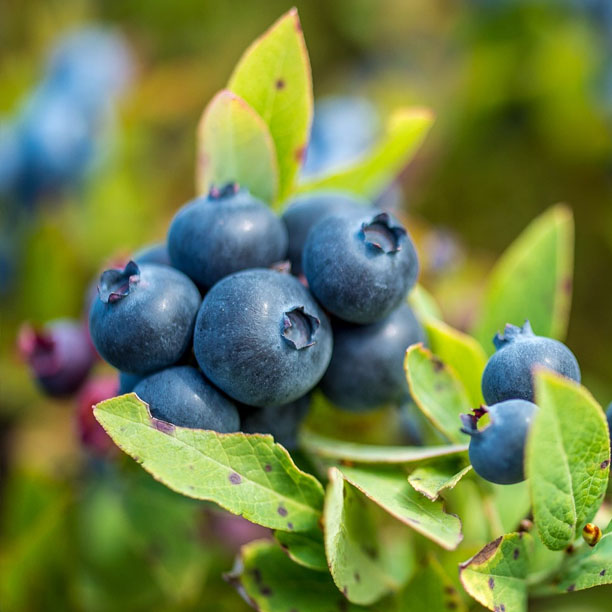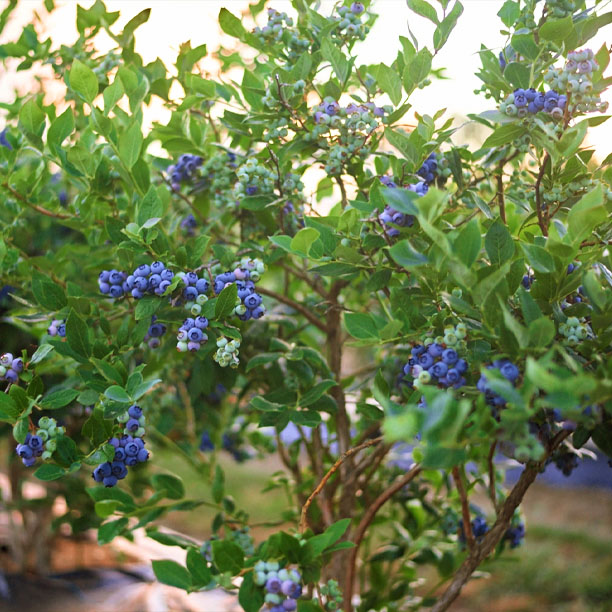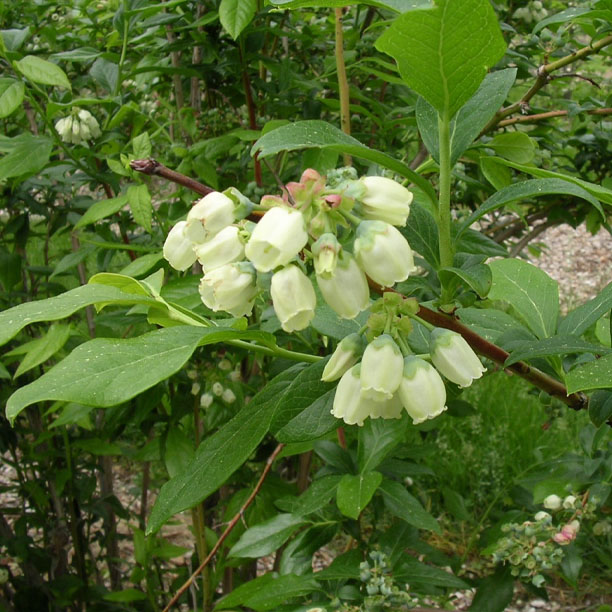Northern Blueberry
How To Identify
Lowbush blueberry shrubs are generally between 6 to 12 inches tall whereas highbush blueberry can grow to be as tall as 12 feet. Blueberry bushes have canes that grow right from the soil that are smooth and don’t have any thorns. The leaves grow on woody branches and are typically stalkless with a glossy finish. They usually take on red hues in the fall and are ovate in shape.
In the spring, wild blueberry plants grow clusters of small white to pink flowers on thin twigs. Each flower comprises five petals fused together into a bell shape. The familiar berries are round and dark blue to almost black, often with a coating of a powdery white bloom on their skins. The tell-tale sign that you’ve definitely found wild blueberry is the presence of a five-pointed crown on the underside of the berry. The berries produced by the wild plants are smaller than cultivated berries, roughly 1/4 inch in diameter, and they contain small, soft seeds.
Blueberries have several lookalikes such as huckleberries, bilberries, serviceberries, and deerberries. Luckily these are also edible. Just remember to identify the five-pointed crown on the underside of the berry. Poisonous lookalikes such as nightshades (belladonna), pokeweed and Virginia creeper berries do not have this feature.



Benefits
The berries and leaves are loaded with antioxidants, chock-full of vitamins and minerals, including vitamin C, K, manganese, and potassium. They’re good for your heart and may reduce your risk of cancer and studies show they’re good for your memory because they slow down the aging of your brain. They can also help manage blood sugar levels and reduce high blood pressure.
How To Find
Blueberries are native to North America and thrive in acidic, fairly dry, gritty soil and grow best in mountainous areas as well as pine barrens. You’ll often find the highbush variety in the same location as the lowbush along with its look-alike cousin the huckleberry. They have a fairly short growing season that lasts from July through August depending on the weather that year.
Gathering
The fruit is ready when it turns from green to blue or purple-blue and the leaves can be harvested at any time of the year but only use leaves that look healthy without spots.
How To Use
You can use wild blueberries the same way you would use cultivated varieties, although you can expect a superior flavor. Wild blueberries are delicious fresh, but they also make excellent preserves and pies. They can also be cooked with local wild spices such as spicebush to make an accompaniment for pork, duck, or game meats.
The leaves can be used fresh or dried to make a medicinal tea. Our preferred method is to dry the leaves for use with tea. To prepare a cup, steep about 2 Tbsp. of dried blueberry leaves by pouring boiling water over them and allowing to infuse for 15 – 20 minutes, then strain and serve or simply stuff a tea ball and steep in your favorite cup or mug.
Preservation
Wild blueberries are best frozen immediately after being picked. Do not wash them first. If you do, they will burst open and turn mushy when frozen. The easiest way to freeze wild blueberries is to spread them out on a cookie sheet and freeze them before bagging them up in freezer bags. Do not thaw the berries before using them in cooking or baking. Freezing them in a single layer keeps the berries from clumping together in the freezer bag.
To dry blueberries, start by blanching them to soften the skins. Bring a pot of water to a boil, turn off the heat, and immediately add the blueberries. Leave the berries in the hot water for 30-60 seconds, then drain them in a colander. Next, place them in a dehydrator at 135°F for 8 to 18 hours. Time will vary with each dehydrator, size of berries and with temperature and humidity levels in your house.
To dry blueberry leaves, place them into a paper bag, or on a screen (window screen or similar) and allow them to dry in a dry dark place with good airflow. They can also be dehydrated using very low or no heat in a standard dehydrator or freeze dried. Oven drying isn’t recommended as the heat can damage the medicinal benefits.